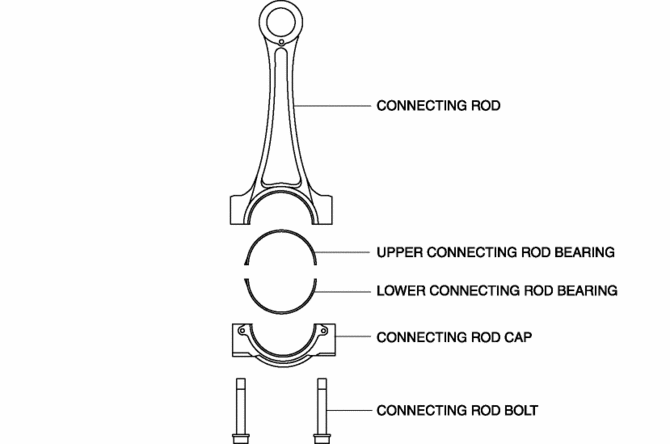Mazda CX-5 Service & Repair Manual: Connecting Rod, Connecting Rod Bearing
Purpose, Function
Connecting rod
-
The connecting rod transmits the reciprocating movement of the piston to the crankshaft by engaging the piston pin and crank pin.
Connecting rod bearing
-
The connecting rod bearing forms an oil film on the outer surface of the crank pin to prevent wear due to sliding.
Construction
Connecting rod
-
The connecting rod is installed between the piston pin and crank pin.
-
High-strength, forged carbon steel has been adopted for weight reduction.
-
A cracking method*1 for breaking off and separating the connecting rod from the connecting rod cap has been adopted for improved accuracy.
-
Weight has been reduced by optimizing the shape from the I shaft to the large end.
-
Reciprocating inertial weight, including the piston, has been reduced with the use of a full-float type for the connection with the piston and further tapering of the small end shape.
-
With the adoption of the plastic region tightening*2 method for the connecting rod bolt, the stability of the axial force has been improved.

*2 Plastic region tightening is a method of controlling the tightening using the rotation angle of a bolt. By tightening to the region (plastic tightening region) in which bolt deformation does not become irreversible, variation in axial force is suppressed.
Connecting rod bearing
-
The connecting rod bearing is installed on the outer surface of the crank pin.
-
The upper and lower connecting rod bearing are made of aluminum alloy.
 Piston Assembly
Piston Assembly
...
 Piston, Piston Ring, Piston Pin
Piston, Piston Ring, Piston Pin
Purpose, Function
Piston
The piston in the cylinder of the cylinder block moves reciprocally by the
pressure received when the air-fuel mixture combusts.
Piston ring
The piston ...
Other materials:
Auto Dimming Mirror Inspection
1. Measure the voltage at each terminal.
If the voltage is not as specified in the Terminal Voltage Table (Reference),
inspect the parts under “Inspection item (s)” and related wiring harnesses.
If the system does not work properly even though the inspection items
or ...
Filament Repair
1. Clean the filament using isopropyl alcohol.
2. Attach tape to both sides of the filament.
3. Using a small brush or marking pen, apply silver paint.
4. After 2—3 min, carefully remove the tape without damaging the applied
area.
CAUTION:
Do not operate the rear window defro ...
Procedure [Plastic Body Parts]
Repair of polypropylene bumpers having damage that has reached the surface of
the polypropylene and are too serious to be restored by painting only.
1. Cut the rough edges around the damage with a knife to make it smooth. Sand
the area with a sander to make an angle of about 45°.
2. ...
